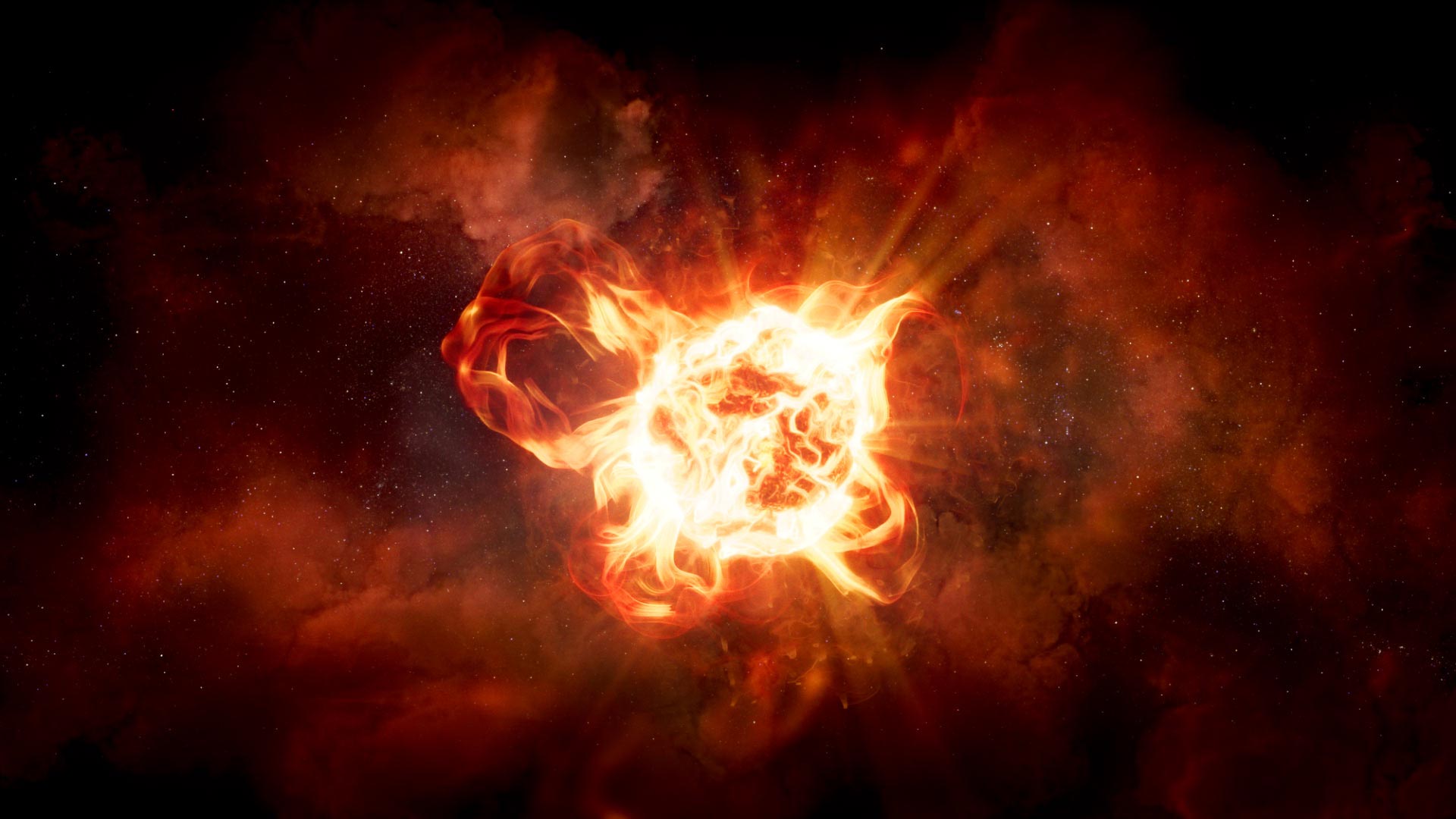Kesan artis tentang bintang raksasa merah VY Canis Majoris. VY Canis Majoris terletak sekitar 3.009 tahun cahaya dari Bumi dan mungkin merupakan bintang paling masif di Bima Sakti. Kredit Gambar: NASA/ESA/Hubble/R. Humphreys, Universitas Minnesota/J. Olmsted, STScI/hublesite.org
Dengan melacak emisi molekuler dalam arus keluar di sekitar bintang raksasa merah VY Canis Majoris, para astronom telah memperoleh peta rinci pertama dari atmosfer bintang, yang menjelaskan mekanisme yang terlibat dalam tahap akhir bintang raksasa ekstrim itu.
Sebuah tim astronom yang dipimpin oleh University of Arizona telah menciptakan gambar 3D rinci dari bintang raksasa yang sekarat. Tim yang dipimpin oleh peneliti UArizona Ambesh Singh dan Lucy Ziurys, melacak distribusi, arah, dan kecepatan berbagai partikel yang mengelilingi bintang raksasa merah yang dikenal sebagai VY Canis Majoris.
Temuan mereka, yang mereka presentasikan pada 13 Juni 2022, pada pertemuan ke-240 American Astronomical Society di Pasadena, California, menawarkan wawasan, dalam skala yang belum pernah terjadi sebelumnya, tentang proses yang menyertai kematian bintang raksasa. Bekerja dengan kolaborator adalah Robert Humphreys dari University of Minnesota dan Anita Richards dari University of Manchester di Inggris.
Bintang raksasa ekstrim yang dikenal sebagai hypergiants sangat langka, dan hanya sedikit yang diketahui tentang mereka[{” attribute=””>Milky Way. Examples include Betelgeuse, the second brightest star in the constellation Orion, and NML Cygni, also known as V1489 Cygni, in the constellation Cygnus. Unlike stars with lower masses – which are more likely to puff up once they enter the red giant phase but generally retain a spherical shape – hypergiants tend to experience substantial, sporadic mass loss events that form complex, highly irregular structures composed of arcs, clumps, and knots.
Located about 3,009 light-years from Earth, VY Canis Majoris – or VY CMa, for short – is a pulsating variable star in the slightly southern constellation of Canis Major. Spanning anywhere from 10,000 to 15,000 astronomical units (with 1 AU being the average distance between Earth and the sun) VY CMa is possibly the most massive star in the Milky Way, according to Ziurys.
“Think of it as Betelgeuse on steroids,” said Ziurys, a Regents Professor with joint appointments in UArizona Department of Chemistry and Biochemistry and Steward Observatory, both part of the College of Science. “It is much larger, much more massive and undergoes violent mass eruptions every 200 years or so.”
The team chose to study VY CMa because it is one of the best examples of these types of stars.
“We are particularly interested in what hypergiant stars do at end of their lives,” said Singh, a fourth-year doctoral student in Ziurys’ lab. “People used to think these massive stars simply evolve into supernovae explosions, but we are no longer sure about that.”
“If that were the case, we should see many more supernovae explosions across the sky,” Ziurys added. “We now think they might quietly collapse into black holes, but we don’t know which ones end their lives like that, or why that happens and how.”
Previous imaging of VY CMa with NASA’s Hubble Space Telescope and spectroscopy showed the presence of distinct arcs and other clumps and knots, many extending thousands of AU from the central star. To uncover more details of the processes by which hypergiant stars end their lives, the team set out to trace certain molecules around the hypergiant and map them to preexisting images of the dust, taken by the Hubble Space Telescope.
“Nobody has been able to make a complete image of this star,” Ziurys said, explaining that her team set out to understand the mechanisms by which the star sheds mass, which appear to be different from those of smaller stars entering their red giant phase at the end of their lives.
“You don’t see this nice, symmetrical mass loss, but rather convection cells that blow through the star’s photosphere like giant bullets and eject mass in different directions,” Ziurys said. “These are analogous to the coronal arcs seen in the sun, but a billion times larger.”
The team used the Atacama Large Millimeter Array, or ALMA, in Chile to trace a variety of molecules in material ejected from the stellar surface. While some observations are still in progress, preliminary maps of sulfur oxide, sulfur dioxide, silicon oxide, phosphorous oxide and sodium chloride were obtained. From these data, the group constructed an image of the global molecular outflow structure of VY CMa on scales that encompassed all ejected material from the star.
“The molecules trace the arcs in the envelope, which tells us molecules and dust are well-mixed,” Singh said. “The nice thing about emissions of molecules at radio wavelengths is that they provide us with velocity information, as opposed to the dust emission, which is static.”
By moving ALMA’s 48 radio dishes into different configurations, the researchers were able to obtain information about the directions and velocities of the molecules and map them across the different regions of the hypergiant’s envelope in considerable detail, even correlating them to different mass ejection events over time.
Processing the data required some heavy lifting in terms of computing power, Singh said.
“So far, we have processed almost a terabyte from ALMA, and we still receive data that we have to go through to get the best resolution possible,” he said. “Just calibrating and cleaning the data requires up to 20,000 iterations, which takes a day or two for each molecule.”
“With these observations, we can now put these on maps on the sky,” Ziurys said. “Until now, only small portions of this enormous structure had been studied, but you can’t understand the mass loss and how these big stars die unless you look at the entire region. That’s why we wanted to create a complete image.”
With funding from the National Science Foundation, the team plans to publish its findings in a series of papers.
Meeting: 240th meeting of the American Astronomical Society

“Pakar bir seumur hidup. Penggemar perjalanan umum. Penggemar media sosial. Pakar zombie. Komunikator.”







More Stories
Legiuner berangkat dalam dua kapal pesiar terpisah yang terkait dengan fitur kemewahan khusus ini: lapor
SpaceX meluncurkan 23 satelit Starlink dari Florida (video dan foto)
NASA mengatakan “Komet Halloween” tidak selamat saat melintasi matahari